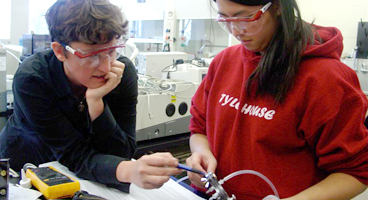Document Type
Article
Publication Date
10-1-2004
Publication Title
Journal of the Acoustical Society of America
Abstract
Reported here is a technique for measuring forward and reverse middle-ear transmission that exploits distortion-product otoacoustic emissions (DPOAEs) to drive the middle ear "in reverse" without opening the inner ear. The technique allows measurement of DPOAEs, middle-ear input impedance, and forward and reverse middle-ear transfer functions in the same animal. Intermodulation distortion in the cochlea generates a DPOAE at frequency 2f1-f 2 measurable in both ear-canal pressure and the velocity of the stapes. The forward transfer function is computed from stapes velocities and corresponding ear-canal pressures measured at the two primary frequencies; the reverse transfer function is computed from velocity and pressure measurements at the DPOAE frequency. Middle-ear input impedance is computed from ear-canal pressure measurements and the measured Thévenin equivalent of the sound-delivery system. The technique was applied to measure middle-ear characteristics in anesthetized cats with widely opened middle-ear cavities (0.2-10 kHz). Stapes velocity was measured at the incudo-stapedial joint. Results on five animals are reported and compared with a published middle-ear model. The measured forward transfer functions and input impedances generally agree with previous measurements, and all measurements agree qualitatively with model predictions. The reverse transfer function is shown to depend on the acoustic load in the ear canal, and the measurements are used to compute the round-trip middle-ear gain and delay. Finally, the measurements are used to estimate the parameters of a two-port transfer-matrix description of the cat middle ear.
Volume
116
Issue
4 I
First Page
2187
Last Page
2198
DOI
10.1121/1.1785832
ISSN
00014966
Rights
© 2004 Acoustical Society of America.
Recommended Citation
Voss, Susan E. and Shera, Christopher A., "Simultaneous Measurement of Middle-Ear Input Impedance and Forward/Reverse Transmission in Cat" (2004). Engineering: Faculty Publications, Smith College, Northampton, MA.
https://scholarworks.smith.edu/egr_facpubs/75



Comments
Archived as published.